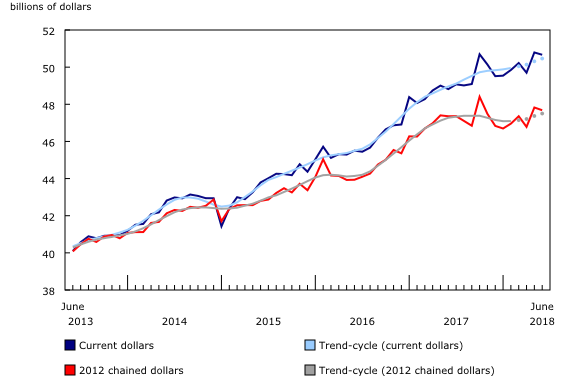Retail trade, June 2018
Archived Content
Information identified as archived is provided for reference, research or recordkeeping purposes. It is not subject to the Government of Canada Web Standards and has not been altered or updated since it was archived. Please "contact us" to request a format other than those available.
Released: 2018-08-22
$50.7 billion
June 2018
-0.2% 
(monthly change)
$0.7 billion
June 2018
-0.8% 
(monthly change)
$0.2 billion
June 2018
-1.0% 
(monthly change)
$1.3 billion
June 2018
-1.2% 
(monthly change)
$1.1 billion
June 2018
0.2% 
(monthly change)
$10.9 billion
June 2018
-0.7% 
(monthly change)
$18.9 billion
June 2018
0.7% 
(monthly change)
$1.7 billion
June 2018
1.8% 
(monthly change)
$1.7 billion
June 2018
1.4% 
(monthly change)
$6.9 billion
June 2018
-1.2% 
(monthly change)
$7.1 billion
June 2018
-1.8% 
(monthly change)
Following a 2.2% increase in May, retail sales edged down 0.2% in June to $50.7 billion. Sales were down in 6 of 11 subsectors, representing 52% of total retail trade.
Lower sales at gasoline stations and motor vehicle and parts dealers more than offset higher sales at food and beverage stores and building material and garden equipment and supplies dealers. Excluding the first two subsectors, retail sales were up 0.3%.
After removing the effects of price changes, retail sales decreased 0.3%.
On a quarterly basis, retail sales were up 1.0% in the second quarter following a 0.5% decrease in the first quarter. In volume terms, retail sales increased 0.9% in the second quarter.
Lower sales at gasoline stations and motor vehicle and parts dealers
After increasing 5.2% in May, sales at gasoline stations decreased 2.3%, in part due to lower prices at the pump in June. In volume terms, sales at gasoline stations decreased 0.4%.
Sales at motor vehicle and parts dealers (-0.7%) were down for the second time in three months. Lower sales at new car dealers (-0.6%) and automotive parts, accessories and tire stores (-3.8%) accounted for the majority of the decline.
Higher receipts were reported at food and beverage stores (+0.9%). Gains were reported at all store types within this subsector, led by supermarkets and other grocery stores (+1.2%). Specialty food stores, convenience stores and beer, wine and liquor stores were all up for the fourth consecutive month.
Building material and garden equipment and supplies dealers (+1.1%) and health and personal care stores (+0.6%) also reported higher sales in June.
Sales down in six provinces
Retail sales were down in six provinces in June.
British Columbia (-1.8%) reported the largest decrease in dollar terms, with sales down in 10 of 11 subsectors. Following a 1.0% decline in May, lower sales were also reported in the census metropolitan area (CMA) of Vancouver (-2.1%).
After increasing for five consecutive months, retail sales declined 1.2% in Alberta. Despite this decline, sales remain above the level in April.
In Quebec, retail sales declined 0.7%, largely due to lower sales at new car dealers. Retail sales in the Montréal CMA (-0.3%) were also down.
Retail sales in Ontario rose 0.7% on the strength of higher sales at food and beverage stores and, to a lesser extent, motor vehicle and parts dealers. In the Toronto CMA (+2.0%), retail sales rose for the fourth time in five months.
Sales continued their upward trend in Manitoba (+1.8%), while retail sales in Saskatchewan rose 1.4%, which more than offset the decline in May.
E-commerce sales by Canadian retailers
The figures in this section are based on unadjusted (that is, not seasonally adjusted) estimates.
On an unadjusted basis, retail e-commerce sales totalled $1.4 billion, representing 2.6% of total retail trade. On a year-over-year basis, retail e-commerce rose 18.0%, while total unadjusted retail sales increased 4.2%
Summary tables of unadjusted data by industry and by province and territory are now available.
For information on related indicators, refer to Latest statistics.
Note to readers
All data in this release are seasonally adjusted and expressed in current dollars, unless otherwise noted. For information on seasonal adjustment, see Seasonally adjusted data – Frequently asked questions.
With this release, volume data in table 20-10-0078-01 have been revised back to January 2009 in order to incorporate updated weights based on annual revisions to the retail commodity survey.
Statistics Canada's retail e-commerce figures include the electronic sales of two distinct types of retailers. The first type do not have a storefront. These businesses are commonly referred to as 'pure-play' Internet retailers and are classified to North American Industry Classification System (NAICS) 45411—Electronic Shopping and Mail Order Houses. The second type have a storefront and are commonly referred to as 'brick and mortar' retailers. If the online operations of a brick and mortar retailer are separately managed, they too are classified to NAICS 45411.
Common electronic commerce transactions, such as travel and accommodation bookings, ticket purchases and financial transactions are not included in Canadian retail sales figures. For more information on individual Internet use and e-commerce, consult the most recent release of the Canadian Internet Use Survey and/or the Survey of Digital Technology and Internet Use.
For more information on retail e-commerce in Canada, see Retail E-Commerce in Canada.
Total retail sales expressed in volume terms are calculated by deflating current dollar values using consumer price indexes. The retail sales series in chained (2012) dollars is a chained Fisher volume index with 2012 as the reference year. For more information, see Calculation of Volume of Retail Trade Sales.
For information on trend-cycle data, see the StatCan Blog and Trend-cycle estimates – Frequently asked questions.
Real-time tables
Real-time tables 20-10-0054-01 and 20-10-0079-01 will be updated on September 10.
Next release
Data on retail trade for July will be released on September 21.
Contact information
For more information, contact us (toll-free 1-800-263-1136; 514-283-8300; STATCAN.infostats-infostats.STATCAN@canada.ca).
For analytical information, or to enquire about the concepts, methods or data quality of this release, contact Jason Aston (613-951-0746; jason.aston@canada.ca), Retail and Service Industries Division.
- Date modified:


